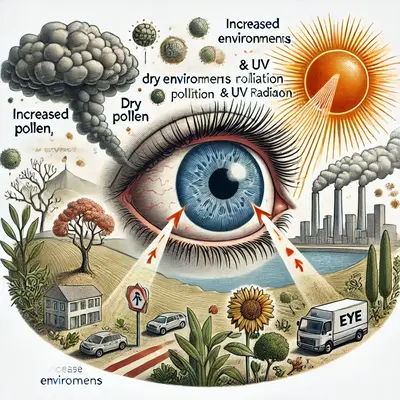Climate change is often talked about in terms of melting ice caps and extreme weather, but there’s a lesser-known impact that hits a lot closer to home—our eyes. Rising temperatures, increasing pollen counts, and changing environmental conditions are leading to a surge in eye-related issues like allergies, dry eyes, and even more severe conditions. Let’s explore how these changes are affecting our eye health and what you can do to protect your vision.

The Climate Effect: A Growing Problem for Eye Health
The environment around us is changing rapidly, and the effects on eye health are becoming more evident. The American Academy of Ophthalmology (AAO) has pointed out that “the rising incidence of eye-related allergies is largely driven by shifts in climate.” Longer pollen seasons and higher concentrations of pollutants are some of the key contributors to these problems.
Here’s a closer look at some of the most common issues:
Allergic Conjunctivitis: It’s Not Just Seasonal Anymore
Climate change has lengthened the pollen season, leading to prolonged symptoms for people suffering from allergic conjunctivitis. This condition, commonly known as eye allergies, results in itchy, red, and watery eyes. For instance, Maria, a teacher in Texas, has noticed that her allergy symptoms now start earlier in the spring and linger well into the fall, leaving her eyes irritated for much of the year.
The increased carbon dioxide levels in the atmosphere have also contributed to higher pollen production. Plants are thriving in the changing climate, producing more pollen and making allergic reactions more severe. According to Dr. Jonathan Williams, an allergist, “The changes in pollen seasons are making life difficult for allergy sufferers, with a marked increase in eye irritation and related symptoms.”
Dry Eye Syndrome: A Desert in Your Eyes
Warmer temperatures and decreased humidity have led to an increase in dry eye cases. As the air becomes drier, the moisture in our eyes evaporates more quickly, leading to discomfort. People living in urban areas, where pollution levels are also on the rise, are especially vulnerable to this condition.
Take Ahmed, who lives in a city with a lot of construction activity. He’s noticed that his eyes are frequently dry and tired, particularly after long days outside. This is because urban pollutants, combined with the drier climate, are wreaking havoc on his tear film—the natural moisture barrier that keeps the eyes comfortable.
The Mayo Clinic has also reported a spike in dry eye cases linked to rising air pollution levels. Dr. Angela Smith explains, “High pollutant levels and drier environments create a perfect storm for dry eye syndrome.”
A Closer Look: The Impact of Climate Factors on Eye Health
Below is a table that summarizes the key climate factors contributing to eye health issues:
| Climate Factor | Eye Health Impact | Common Conditions |
|---|---|---|
| Rising Temperatures | Increased tear evaporation | Dry Eye Syndrome |
| Higher Pollen Levels | Eye irritation, allergies | Allergic Conjunctivitis |
| Increased Air Pollution | Eye surface inflammation | Dry Eye, Conjunctivitis |
| UV Radiation Exposure | Damage to eye tissue | Cataracts, Macular Degeneration |
UV Radiation: The Overlooked Culprit
Climate change is also increasing the amount of UV radiation we’re exposed to. As the ozone layer depletes, more UV rays reach the Earth’s surface. This has serious implications for eye health, including an increased risk of cataracts and macular degeneration.
Sofia, who loves outdoor activities, never used to think much about sunglasses. Now, she finds herself wearing them more often to protect her eyes from the stronger sun. UV-blocking sunglasses are an essential tool to reduce exposure, as excessive UV radiation can lead to long-term damage.
What Can You Do to Protect Your Eyes?
While the climate is beyond any individual’s direct control, there are steps you can take to protect your eyes from these environmental effects:
- Wear Sunglasses: Always wear sunglasses that block 100% of UV rays when you’re outdoors.
- Use Eye Drops: Artificial tears can help alleviate dry eye symptoms, especially on days with high pollution or dry conditions.
- Limit Outdoor Exposure During Peak Allergy Season: On high pollen days, limit your time outdoors or consider wearing protective eyewear to minimize exposure.
Digital Eye Strain: The Compounding Effect
Climate change isn’t just impacting the environment directly. With hotter temperatures outside, many people are spending more time indoors, leading to an increase in screen time. Prolonged exposure to screens can cause digital eye strain, which further aggravates dry eye and related symptoms. It’s important to follow the 20-20-20 rule: every 20 minutes, look at something 20 feet away for at least 20 seconds.
As Dr. Rachel Johnson from the Eye Health Institute states, “Our eyes are being affected not just by the environment but also by the way our behaviors are changing in response to that environment.”
The Road Ahead: What Needs to Change?
Addressing climate change isn’t just about saving polar bears or preventing sea level rise—it’s also about the everyday health issues we face, including our eyes. Advocacy for cleaner air, sustainable practices, and support for climate initiatives is key to reducing the environmental triggers that affect eye health. Small changes on an individual level can add up, making a difference in the quality of life for everyone.
Eye Health and Climate Change: A Recap
To sum up, climate change is having a direct impact on our eye health through increased pollen levels, rising temperatures, and enhanced UV exposure. Eye allergies and dry eye syndrome are becoming more common, and even our changing habits—like more screen time—are compounding the issue. Protecting your eyes starts with understanding these risks and making simple changes to your daily routine.
“Eye health isn’t just a medical issue; it’s an environmental one too. The more we understand about these connections, the better we can prepare and protect ourselves,” says Dr. Michael Anderson, an environmental health researcher.
Protect Your Vision in a Changing World
Climate change isn’t just a far-off threat—it’s impacting our lives in ways we might not expect, like our eye health. By taking small, preventative steps, you can help mitigate some of these effects and keep your vision clear and comfortable. Keep sunglasses on hand, stay informed about pollen counts, and make lifestyle adjustments to protect your eyes from the changing world around us.





